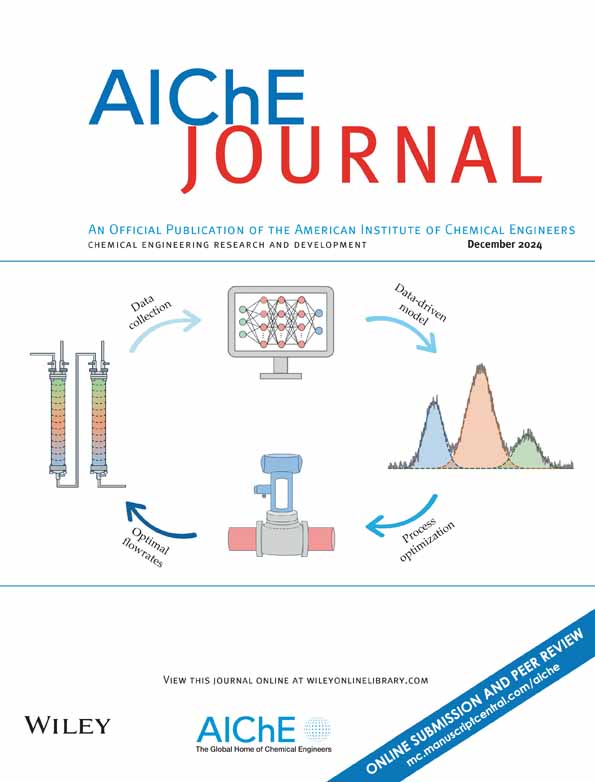Chloride-resistant seawater electrolysis via hydroxyl network-tailored NiFe hydroxide catalysts on stainless steel
IF 3.5
3区 工程技术
Q2 ENGINEERING, CHEMICAL
引用次数: 0
Abstract
Hydrogen production via seawater electrolysis is limited by chloride corrosion and slow oxygen evolution reaction (OER) kinetics. Here, we present hydroxyl network-engineered NiFe hydroxide catalysts on stainless steel (SS-NiFe-X) via a rapid one-step electrodeposition strategy. During OER, the NiFe hydroxide layer transforms into an active NiFeOOH/NiOOH phase, while in situ-generated surface hydroxyl networks establish hydrogen-bond-mediated pathways that simultaneously enhance OER activity and shield against chloride attack. SS-NiFe-60, with a 500 nm oxide layer, sustains 400 mA cm−2 for over 500 h in an aggressive chloride environment (1.0 M KOH + 2.0 M NaCl), while the bare SS experiences complete deactivation within 1 h. Operando studies reveal that the hydroxyl network could block chloride penetration by electrostatic repulsion and facilitate OER intermediate adsorption, validated by a membrane electrode assembly electrolyzer stably delivering 250 mA cm−2 for over 100 h. This scalable design bridges mechanistic insights with industrial seawater electrolysis applications.耐氯海水电解通过羟基网络定制的NiFe氢氧化物催化剂在不锈钢上
海水电解制氢受到氯离子腐蚀和慢析氧反应动力学的限制。在这里,我们通过快速一步电沉积策略在不锈钢(ss - nfe - x)上提出了羟基网络工程的NiFe氢氧化物催化剂。在OER过程中,NiFe氢氧化物层转变为活性NiFeOOH/NiOOH相,而在原位生成的表面羟基网络建立了氢键介导的途径,同时增强了OER活性并屏蔽了氯化物的攻击。SS- nfe -60具有500 nm的氧化层,在侵略性氯化物环境(1.0 M KOH + 2.0 M NaCl)中维持400 mA cm - 2超过500小时,而裸SS在1小时内完全失活。Operando研究表明,羟基网络可以通过静电排斥阻止氯化物渗透,并促进OER中间吸附,通过膜电极组装电解槽稳定提供250 mA cm - 2超过100小时。这种可扩展的设计将机械见解与工业海水电解应用相结合。
本文章由计算机程序翻译,如有差异,请以英文原文为准。
求助全文
约1分钟内获得全文
求助全文
来源期刊

AIChE Journal
工程技术-工程:化工
CiteScore
7.10
自引率
10.80%
发文量
411
审稿时长
3.6 months
期刊介绍:
The AIChE Journal is the premier research monthly in chemical engineering and related fields. This peer-reviewed and broad-based journal reports on the most important and latest technological advances in core areas of chemical engineering as well as in other relevant engineering disciplines. To keep abreast with the progressive outlook of the profession, the Journal has been expanding the scope of its editorial contents to include such fast developing areas as biotechnology, electrochemical engineering, and environmental engineering.
The AIChE Journal is indeed the global communications vehicle for the world-renowned researchers to exchange top-notch research findings with one another. Subscribing to the AIChE Journal is like having immediate access to nine topical journals in the field.
Articles are categorized according to the following topical areas:
Biomolecular Engineering, Bioengineering, Biochemicals, Biofuels, and Food
Inorganic Materials: Synthesis and Processing
Particle Technology and Fluidization
Process Systems Engineering
Reaction Engineering, Kinetics and Catalysis
Separations: Materials, Devices and Processes
Soft Materials: Synthesis, Processing and Products
Thermodynamics and Molecular-Scale Phenomena
Transport Phenomena and Fluid Mechanics.
 求助内容:
求助内容: 应助结果提醒方式:
应助结果提醒方式:


